Confident Man: Sabato De Sarno Unveils Gucci Menswear
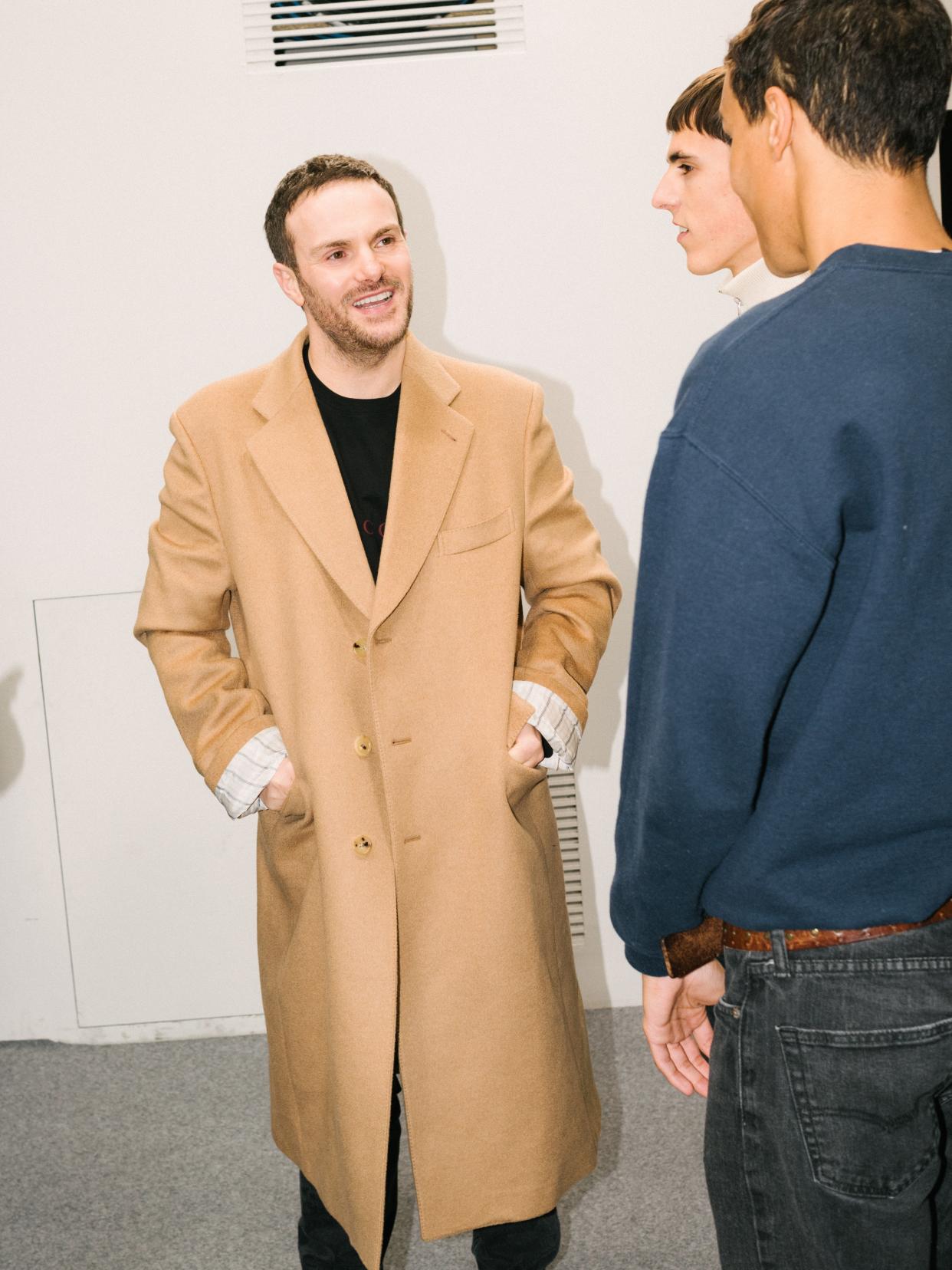
- Oops!Something went wrong.Please try again later.
- Oops!Something went wrong.Please try again later.
Photo: Federico Ciamei / Courtesy of Gucci
On a cold day in January, Gucci’s vast campus on the edge of Milan is still and pin-drop quiet. I have arrived, apparently, during peak lunch hours, and everybody is in the cafeteria. But the scene conveys an appropriate amount of tension. In two days, the brand’s freshman creative director, Sabato De Sarno, will lead off Milan Fashion Week with his first men’s show. Down a hallway painted in the house’s fresh shade of glossy, almost bloody red, I find the designer in his tidy new office.
We sit down on a large white couch, and De Sarno immediately apologizes for his English. The Naples native spent the holidays with his family, and this is the first time he’s speaking it all year. He needs to study up for interviews like this, he says—just one of the many things he’s had to adjust to in his new job as the creative head of a $10 billion brand.
Before his appointment was announced early last year, De Sarno, 40, spent his career as a relatively unknown studio hand, first for Prada and then for Valentino. At Gucci, he’s responsible for a 200+ person design team, which was recently moved from Rome to these global corporate headquarters in Milan. De Sarno, who wears a uniform of black T-shirt and black Levi’s every day, as simple as his close-cropped haircut, says the job hasn’t changed him. “I don’t want to be a king of something. I don’t like to just sit here, saying yes or no. To me, I get bored in three seconds with that. I want to stay with people and build something together. I want to do.” I get the sense that he doesn’t actually spend all that much time at his spotless black desk.
Another point of adjustment is in his new relationship with fashion critics. As head of ready-to-wear at Valentino, he remained just out of frame. Now, all the expectations and scrutiny are aimed squarely at him. His first show, in September, took the brand in a totally new direction from his predecessor, Alessandro Michele. During his eight-year tenure, Michele created an airtight cinematic universe of style and taste that was funky and maximalist. De Sarno, however, is not a storyteller. “I’m the opposite of conceptual,” he tells me.
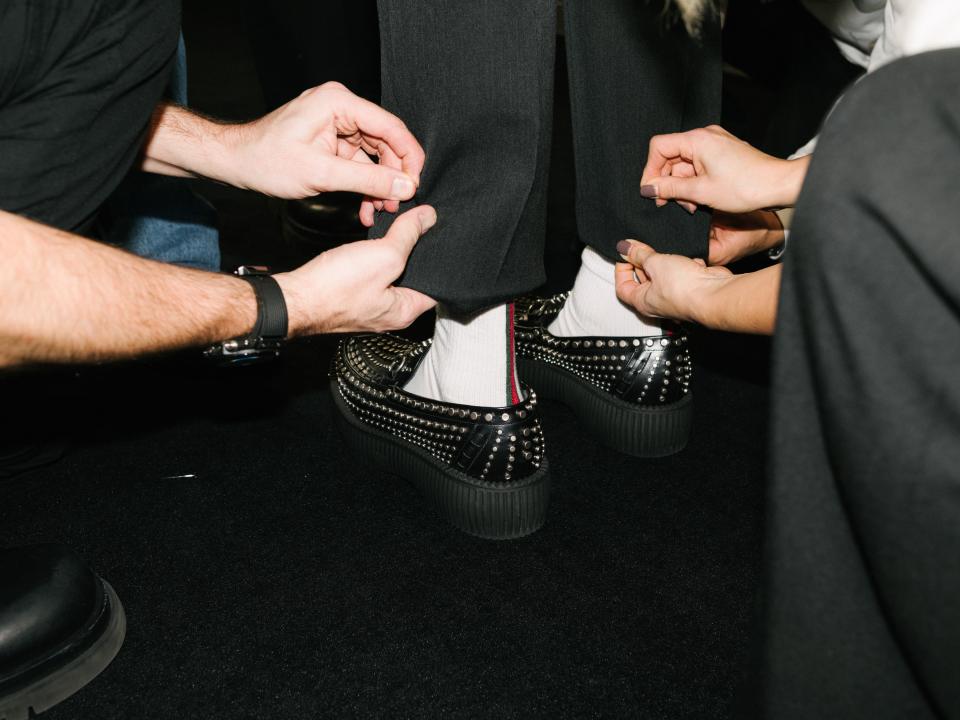
His debut, a women’s collection, instead proposed a modern girl-about-town wardrobe of crisp daywear, like simple tailored blazers, leather A-line skirts, sailor tops, and even a hoodie. De Sarno was ushering in a major aesthetic shift at the house, and bringing with it a fundamentally different way of thinking about fashion, which is essentially that Gucci should be in the business of making clothes rather than costumes. “I love when you see the people under the clothes, not the clothes on the people,” he says. “I don't like to see people wear a Gucci outfit or a Gucci brand, but you lose completely the humanity and the personality. This is something that happens in the theater, but fashion is real. It is real life, it is day wear, it is everyday looks.”
Was it exactly the practical and commercial reset that Gucci wanted when they replaced Michele with De Sarno, as parent company Kering eyes growth to $15 billion? Some critics pointed out that the first collection seemed undercooked, and too plain. But most agreed that De Sarno—like any new creative director—should be given time to hit his stride.
His debut contained several references to Tom Ford-era Gucci, and here he adds another characteristic that links him to Ford: a level of spicy candor that is rarely shared by big league designers today. When he mentions that, to him, fashion is desirability, I point out that some found his collection lacking in just that. Later, he tells me the only opinions he cares about are his mom’s and his husband’s. Leaning sideways on the pillowy couch, De Sarno seizes the opportunity to vent. “If you see those people, what can we do in their life? Nothing, maybe,” he says. Does he mean critics? “I love critics,” he says. But he also loves and will defend his collection several times over the course of our chat. “I think my show was wow, more than wow,” he says. Perhaps, he suggests, the reception was mixed because we’re trained to respond to Instagram-friendly spectacle rather than subtlety. That’s not his thing. “If for the people wow is to have a big dress or a sparkly everywhere or a top model—it's also wow, but that’s not a Sabato way,” he says.
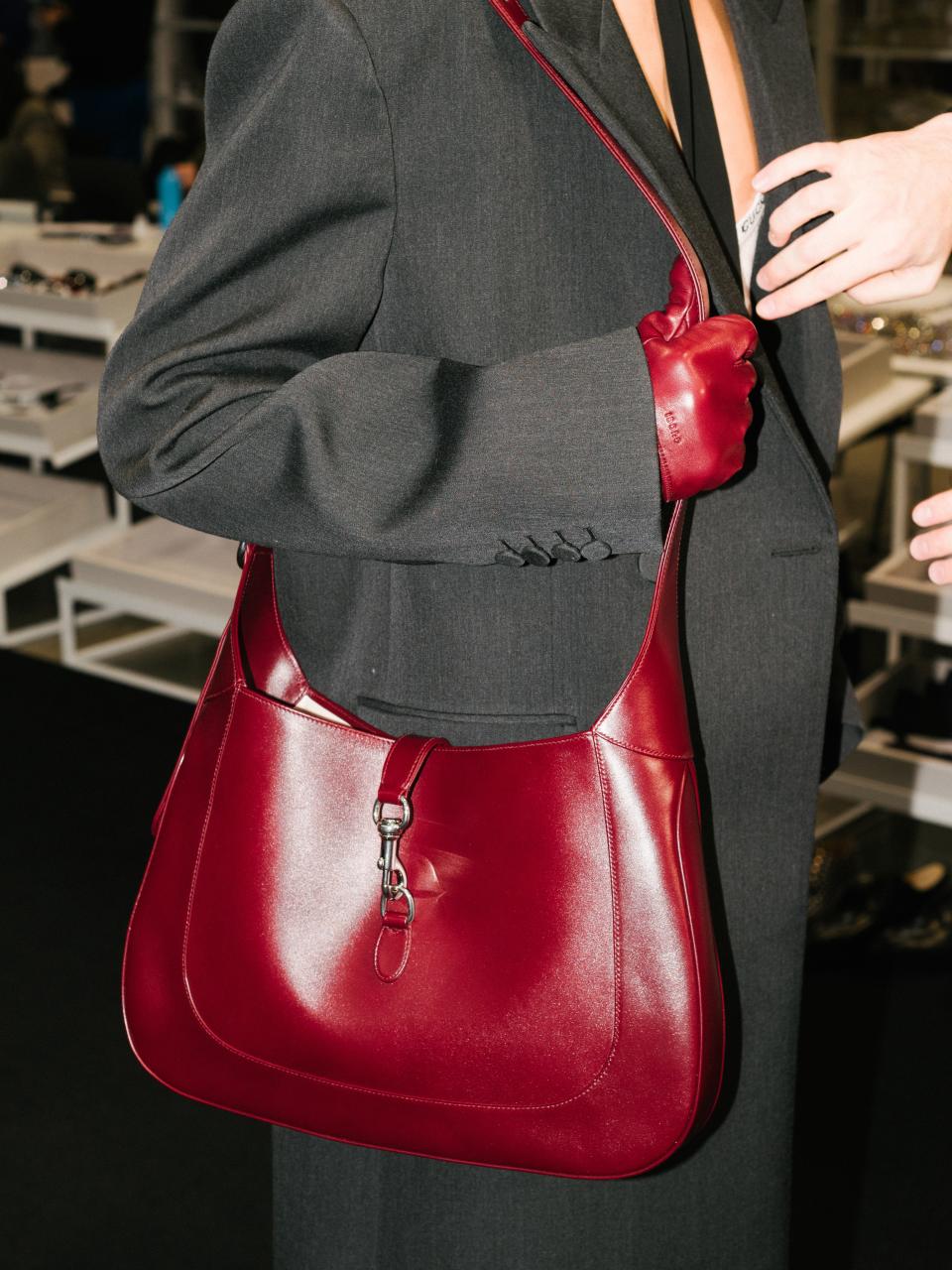
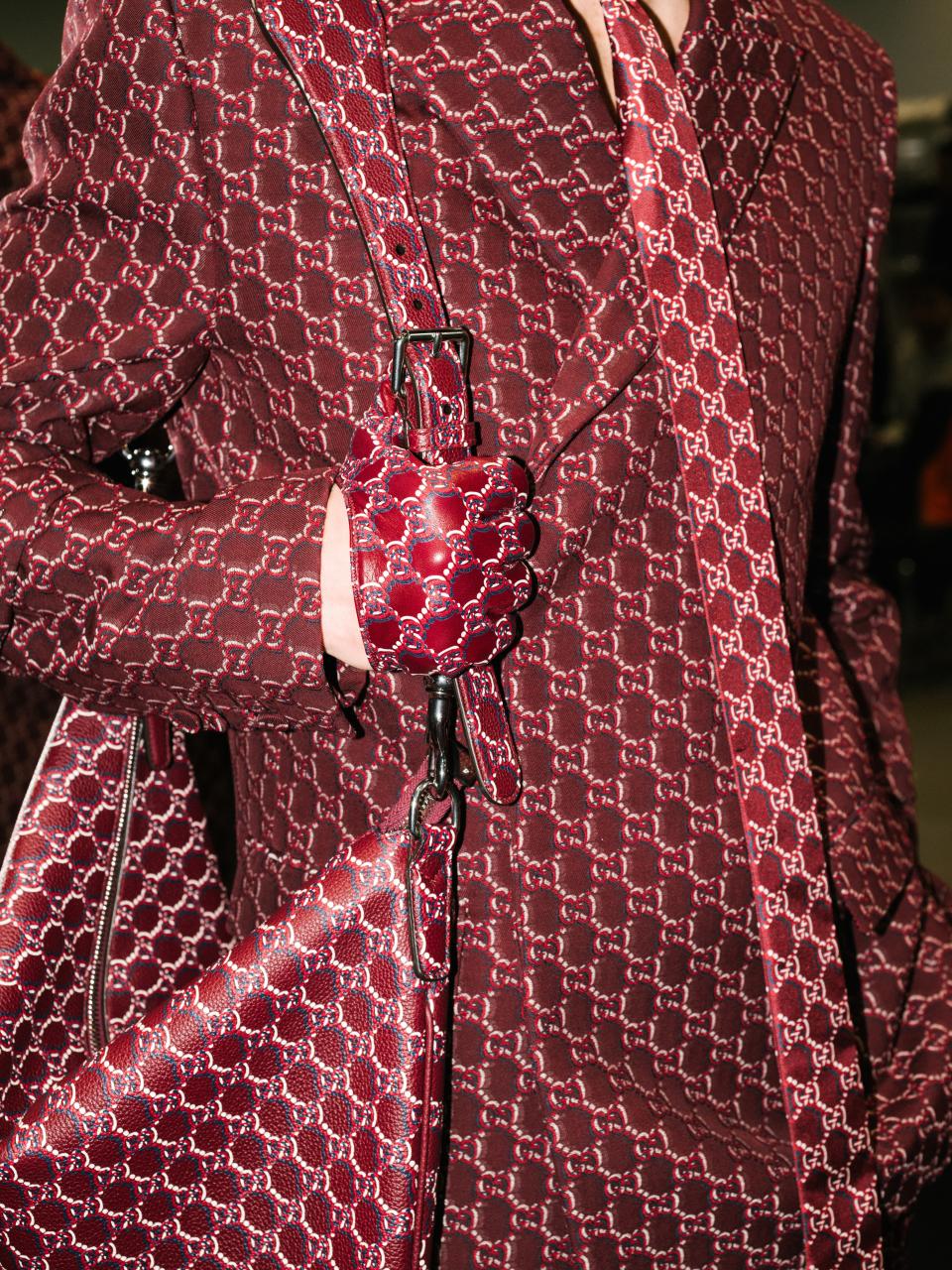
As a young aide pipes in with the occasional translation, De Sarno continues, heating up. He welcomes criticism, he says, but remember—he is a person who does. He looks unkindly on those who simply talk. “The people say they love changes, but they don't really love change, they don't want to change,” he says. “I think this is the big problem about this world. The people just talking, ‘I love the changes,’ it's not true, it's not really true. The people, some of them, if they know better than me what I can do for Gucci, come! Help me. If you know, come to me and we can do work together.”
I don’t think he’s thin-skinned or still adjusting to the spotlight. De Sarno clearly considers fashion design a highly dignified profession that’s been twisted into something more like a performance. He takes his job incredibly seriously, and bristles at disrespect. “If you come to my show and watch my show from your iPhone, I prefer you stay at home and watch from the iPad, it's bigger than iPhone and maybe you understand better,” he says, only half-joking. “I think fashion is a serious thing,” he continues. “It’s a job. We move a lot of money, we give work to many families.”
In his office, I begin to understand why De Sarno doesn’t want to be king. Heavy is the head, of course. But to him, the role of creative director is not the abstraction that it’s become in the popular imagination. (There were times when his predecessor was regarded more like a deity or an idea than a real person.) The job at its core is about going to the design studio every day and making clothes. Real clothes for real people to wear. “I love fashion, and I think most people love the idea of fashion,” he concludes. “I love fashion. Not just the idea.”
Say you’re a creative director at a major luxury house and you are immensely proud of your debut collection, but you don’t think your audience fully appreciated what you were trying to say. What would you do? Would you revise your point-of-view to please them, or would you double down on it?
For his big menswear launch, De Sarno is doubling down in a radical and unexpected way. “The concept,” he says, “is a mirroring of the September show.” We’ve just arrived in a hangar-like studio where his runway team is assembling the final looks. Many designers exchange themes between men’s and women’s collections, but De Sarno’s approach takes it even further. Each look in the men’s show corresponds with one from the women’s, a quite literal interpretation of Gucci Ancora, the theme of De Sarno’s rebrand. (Ancora means “again,” as in: “I want more!”) Some outfits are the same, but fit for men. Some are lightly reinterpreted, and others share colors or fabrics. The mirroring extends to the black box show venue and Mark Ronson soundtrack, the same one that played in September. It’s a risky move: to take a polarizing collection and run it back at an incredibly high-stakes moment.
It’s also a rebuke to critics. I ask De Sarno to explain. “What I did, I really loved. It was my first show for Gucci and I really believe in what I did, and this means I still believe in that,” he says. He’s standing in front of a moodboard bearing a famous image of the playwright Samuel Beckett in 1971, a soft Gucci hobo bag slung coolly over his shoulder. He brought it to his job interview with Gucci brass, and now he needs to show the world an idea of style that is just as clear. “I want to make the people understand my vision,” he says.
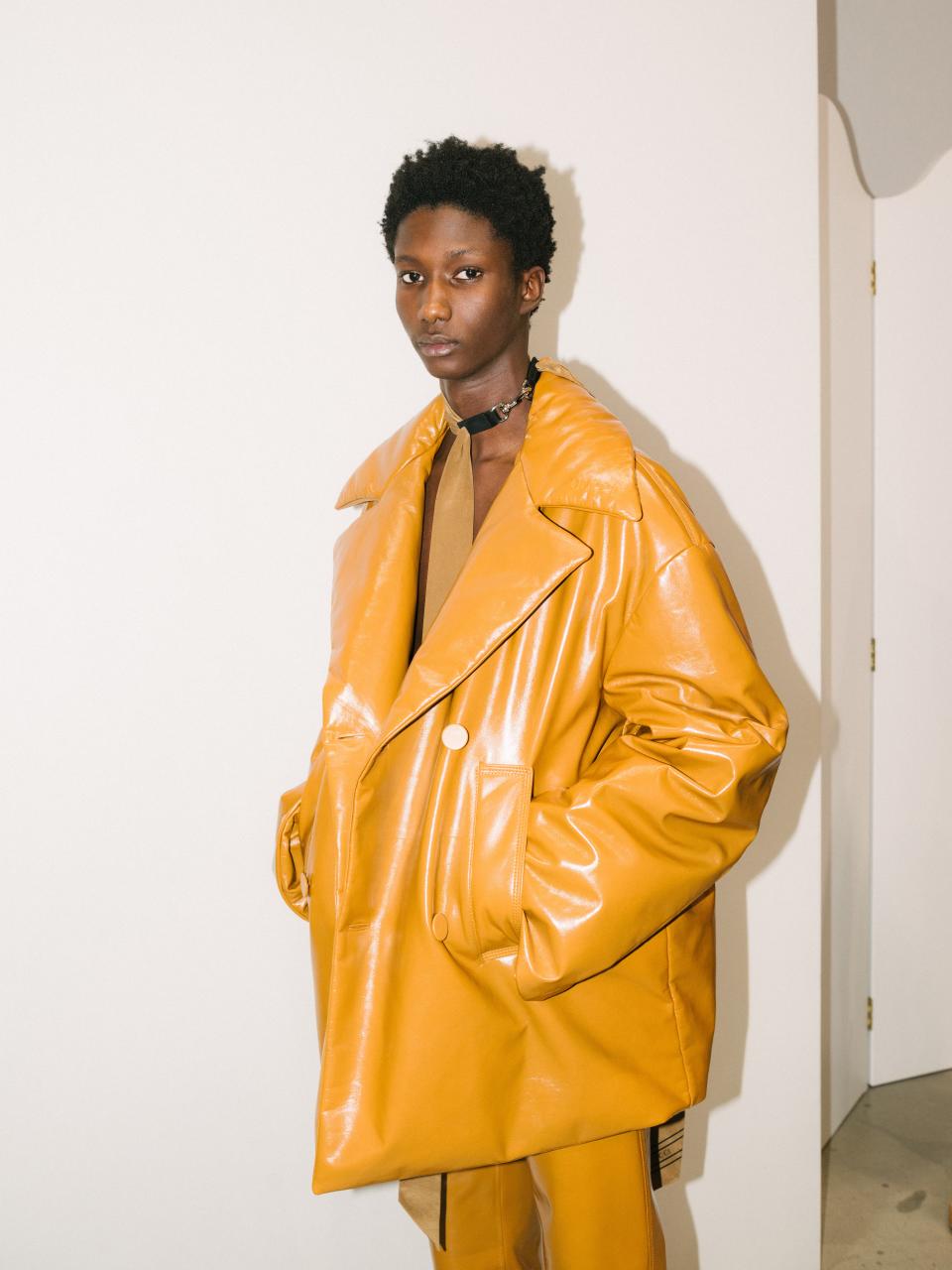
Born in the village of Cicciano near Naples, De Sarno’s vision began taking shape at a very young age. “I was very passionate about the way people chose clothes in order to align with their personality,” he recalls of his childhood years. “The clothes help people be what they wanted to be.” As a gay teenager in a small town, this was a very personal concern for De Sarno. “Being a designer, it means finding a way to express myself, finding a way to be Sabato. The fashion helped me be myself.” A young De Sarno was fascinated with Gianni Versace. “In a way we have a same story,” he says. “He was born in the South of Italy, he was gay, he was very in with his family, the family was the center of his life. I remember when I was 12, 13, I just projected my life to be like Gianni Versace’s life, dreaming to be a designer.”
Besides a passion for clubbing, music, and art, De Sarno’s life is considerably less flashy than Versace’s was—he has a lawyer husband who lives in Brussels and two dachshunds. But Versace’s suits left an impression on De Sarno, one that has morphed into a full-blown obsession with coats. Once he graduated from fashion school in Milan—“I love to be the top student,” he says—De Sarno landed at his first fashion house as an assistant pattern-maker at Prada. From there he bounced to Dolce & Gabbana before landing at Valentino, where he began working on menswear for the first time.
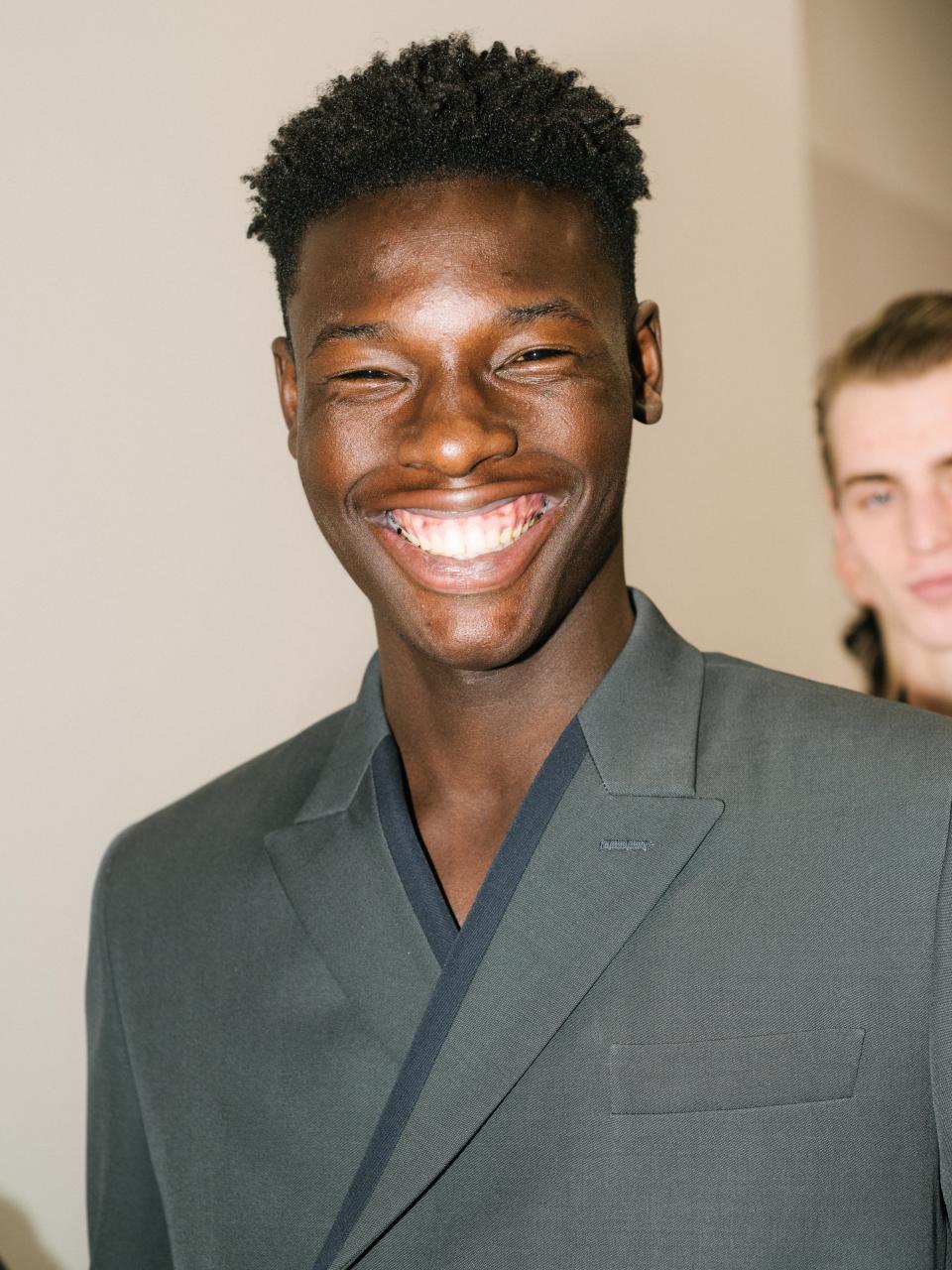
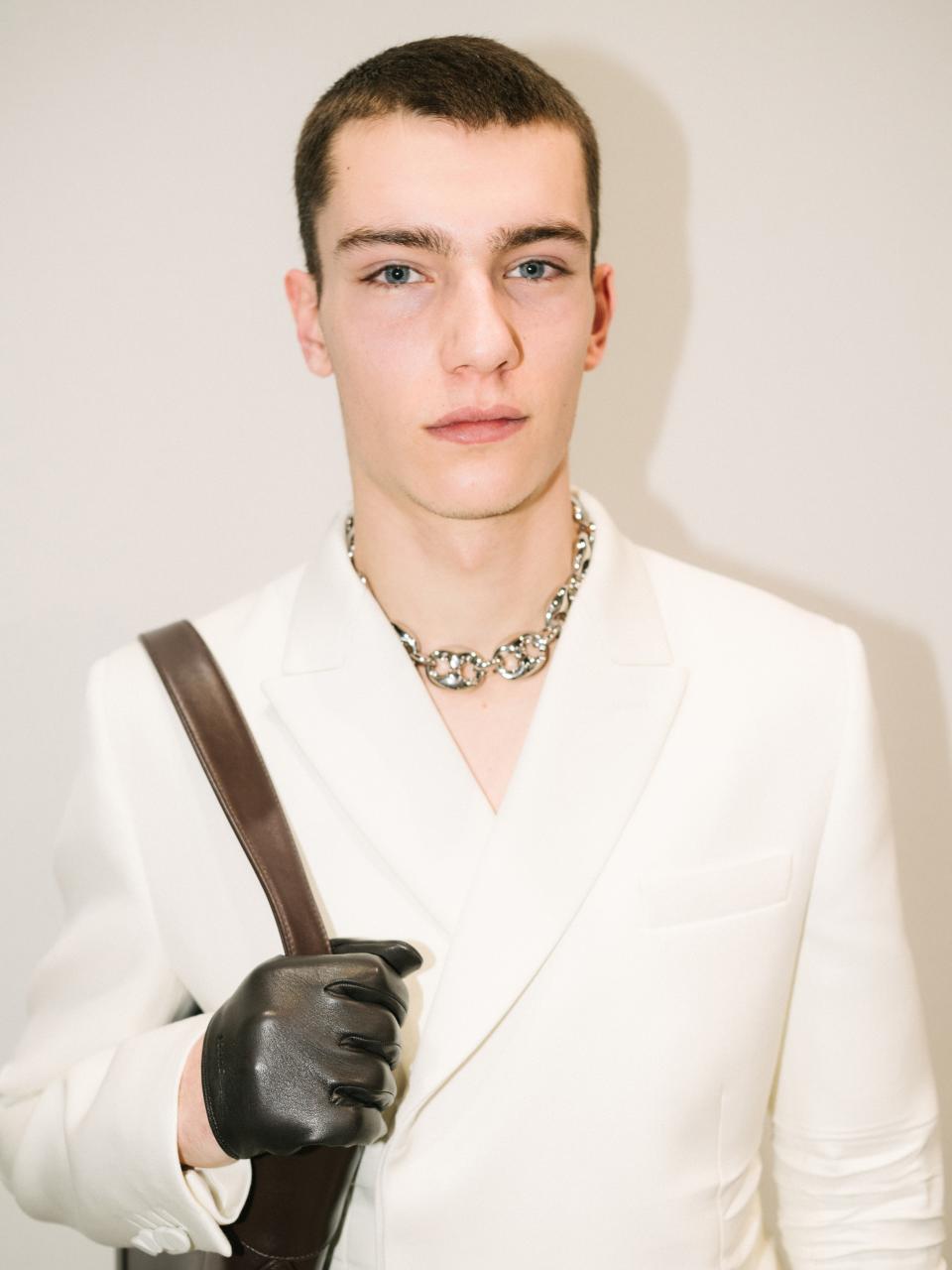
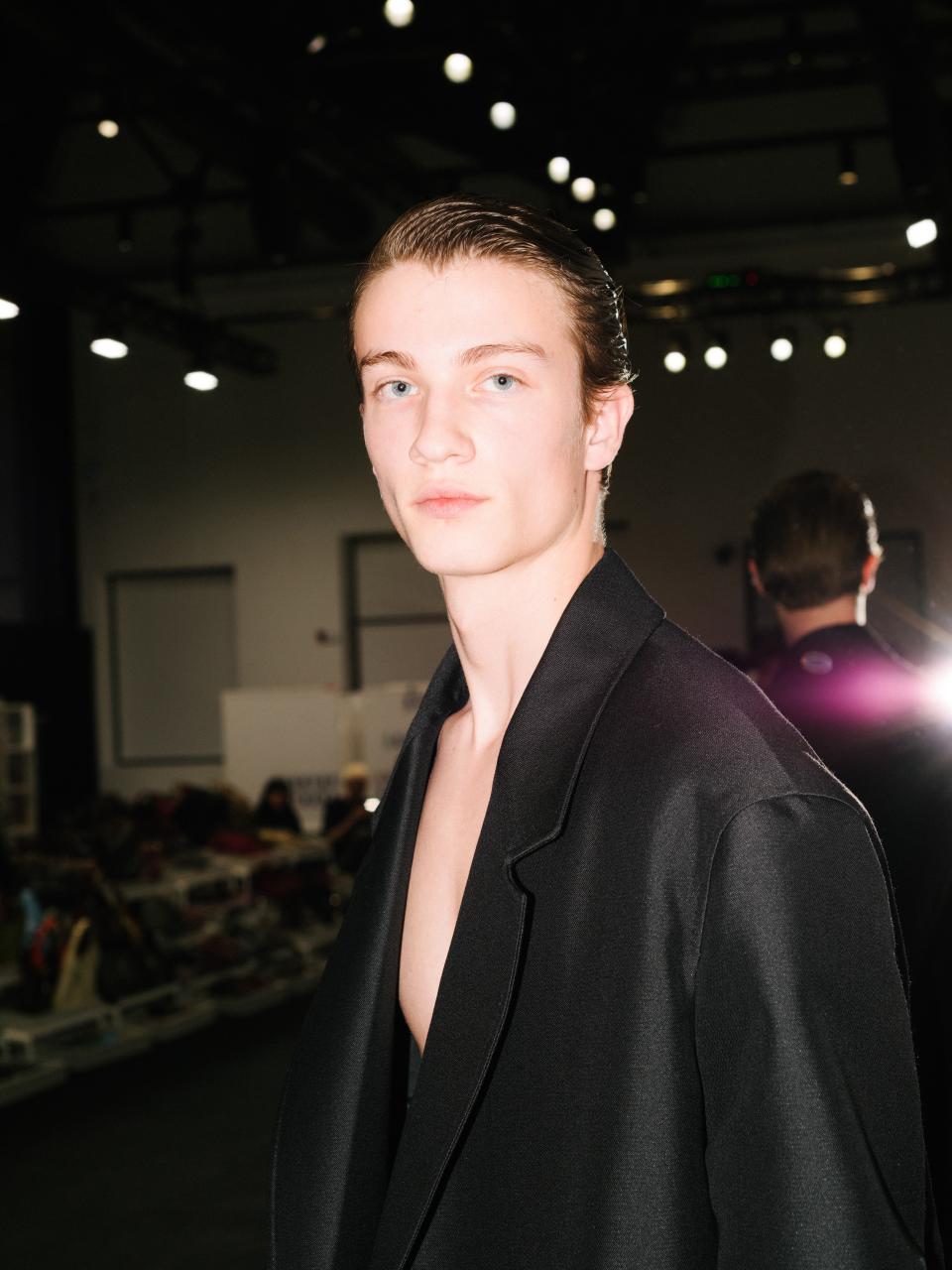
I ask him if he remembers the first piece of men’s clothing he designed. “I started with coats,” he says, a dreamy look in his eyes. “My passion is for coats, I'm very obsessed with coats, I collect them.” He currently owns over 200 of them, and has added 15 or so from Gucci alone since September. In keeping with his uniform, he wears black coats but buys colored ones too, just to have. Or he’ll fall in love with a fabric or a shape—his realist approach to fashion should not be misinterpreted as dispassionate. “A coat is something that makes me more secure,” he says. “I love when I wear it because I always have it longer, and I love double-breasted coat in order to hug. It's an intimate approach with a coat, I think. The coat is more intimate than other things because it hugs yourself. Wraps you in a way. In the kind way.”
In the showroom, the coats stand out on the rack for their sheer length. They are cut in cozy columns around the torso, and would be ankle-grazing on even the tallest models. De Sarno pulls out the opening look, the same beautiful gray topcoat that began his show in September. He points out the design details that will surely not be visible on the runway: the super dense custom wool fabric, the slightly oversized but still “very controlled” shape, the embroidered “Ancora” on the inside lining. “It's something that you don't see in the picture, but if you buy it or if you wear it, you feel it,” he says. “I'm not interested in just show, show, show. I love to curate the pieces and I think this is the example of the curated coat.”
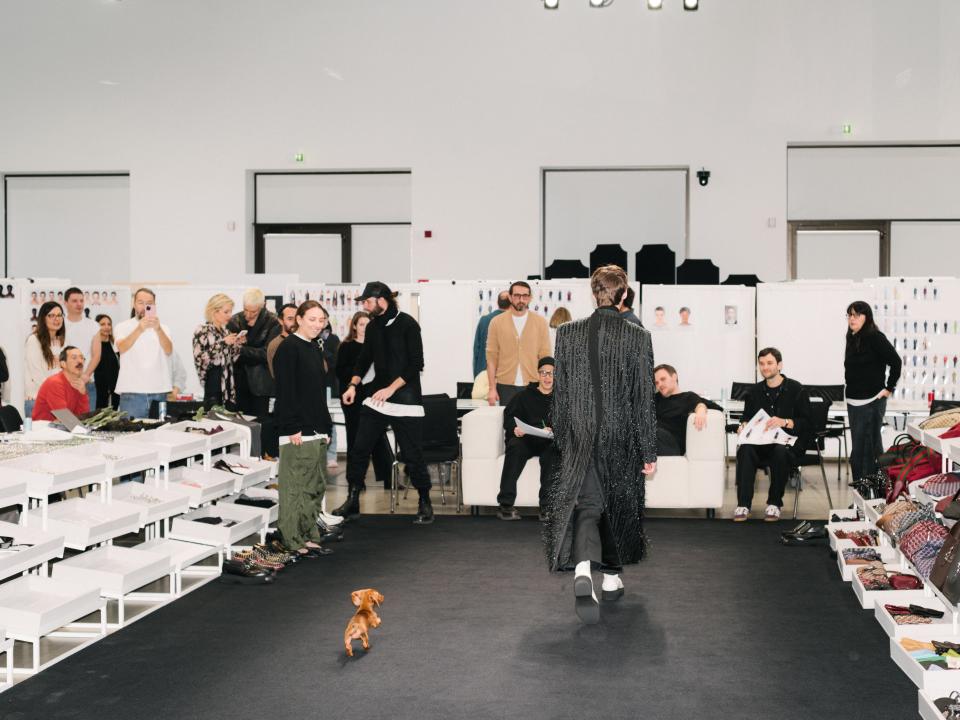
Continuing down the rack, De Sarno pointed out more pieces from the women’s side of the store, like a series of zip-up leather jackets, a thick wool peacoat, and a sailor knit with glittering sequins embroidered across the collar. (In addition to coats, De Sarno loves leather and a little flash.) There are further indulgences—some wardrobes are wilder than others—in the outerwear department, where you’ll find floor-length python dusters and a couture-like embroidered car coat. Through the mirror, suits replace mini-dresses, though a crystal-woven tank top is refracted for men. “Why not?” De Sarno says. He is introducing two tailoring fits, one tight and rigid, “very English,” he says, and another that’s elegantly relaxed, “more Nineties,” which also comes as a tuxedo that Ryan Gosling would be wise to pick up. Beckett’s hobo bag is back, this time in the signature hues of “Ancora Rosso,” and the models will wear a new version of the house’s classic horsebit loafer—a thick-soled creeper.
As we observe a few models testing out looks, it strikes me that he will probably sell a lot of this collection. Men appreciate clarity, and they tend to love coats, and hey, who doesn’t want to emulate Samuel Beckett in his Italian era? I would bet that critics will warm up, too—it’s tightly edited but fuller than his debut, with a lush, textural emotion to it. This time, De Sarno’s straightforward approach works. There’s basically nothing lost in translation in his opening menswear effort.
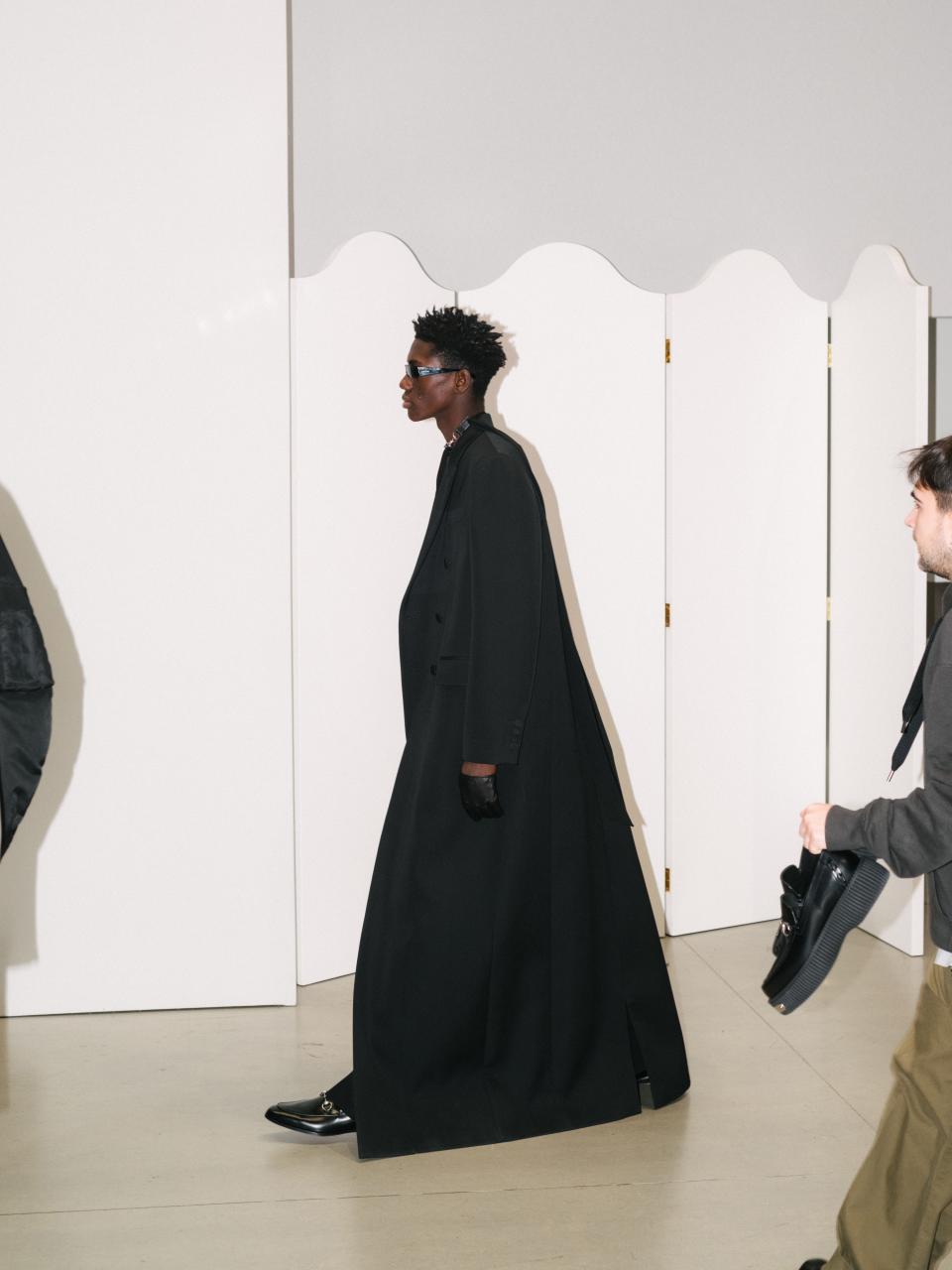
Before I leave, I ask De Sarno how he’s feeling a few days before the critics take their front-row seats. “Honestly, I don't feel the pressure,” he says. “Not because I'm the best, I don't think that, just because I deliver things that I like. And if I'm conscious about that, this is the good way to do this job. Because if I start to think about the critics or the comments—everyone will have a solution for something, or everyone wants to suggest something.” De Sarno, perhaps unsurprisingly, strikes the tone of someone who does. “This is the word: confident,” he says. “I really love the collection, from look one to the last look. And I feel very confident.”
Originally Appeared on GQ

